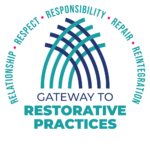When I started restorative practices training for schools over a decade ago, I looked at California schools’ websites that were known for their success. When I develop restorative practices workshops, I always include related resources for participants. In our all-day RP 101: Intro to Restorative Practices I include a list of Dr. Marian’s “Go to” websites. This blog post features three California websites. Note that San Franciso Unified School District (SFUSD) used to share extensive resources. Unfortunately, most content is only accessible to employees. Today we’re exploring Oakland Unified School District; San Diego County Office of Education; and Los Angeles Unified School District. I’m hoping my readers will enjoy exploring these websites.
Program 1: Oakland Unified School District: Restorative Justice
You can access their website here. https://www.ousd.org/restorativejustice

Oakland Unified School District is the “Go to” Restorative Practices program in California. They had so many visitors on campus that they’ve closed visitation options. But their website is extensive, including strategies written by their staff. I’ve used quite a few of them over the years. I found some new ones today. Under their whole-community tab they offer content in four key areas: Introducing Restorative Justice, Community Building Circles, Conflict Resolution, and Learning from Others. My favorite item I discovered today is how to create a regulation station with information and pictures.
Another tab is their well-recognized Peer Restorative Justice Program. If you’d like to implement this at your site with secondary students, they have everything you could need. Build the Team features practical items, such as a permission form, student application, and peer leaders’ commitment. They also offer a way to customize their peer mediation program for your school site.
They offer an OUSD Restorative Justice Elementary Toolkit. Unlike most “toolkits” that are compiled, you access the documents you want on their website. Under their classroom resources, I uploaded several documents from Making S.P.A.C.E. for Learning. They offer a similar format for Routines and Skills. Here’s what their S.P.A.C.E. acronym means.
- S – Sensory Equipped
- P – Private-ish
- A – Accessible
- C – Comfortable
- E – Engaging in Schools
Program 2: San Diego County Office of Education: Restorative Justice Practice
You can access their website here. https://www.sdcoe.net/students/whole-child-and-community-design/restorative-justice-practices

One of my favorite sites for all things Restorative Practices is the San Diego County Office of Education: Restorative Justice Practices. SDCOE offers a monthly RP collaboration I’ve been attending since April 2023. This collaboration with other restorative practitioners is the highlight of my month. I also attended an excellent free virtual workshop on the Alignment of Restorative Practices and Positive Behavior Interventions and Support (PBIS). If you’re looking for an understanding of how these concepts work together, this workshop is for you.
Their department created a substantial number of videos in different areas, including educator voices; student voices; RP in Action [school sites]; restorative parenting; as well as the Restorative Justice Training Model Series of six videos. I enjoy accessing their SDCOE Shared RP Resources where practitioners can get ideas and post ideas as well. I plan to write about this resource.
Program 3: Los Angeles Unified School District: PBIS and Restorative Practices

You can access their website here. https://www.lausd.org/PBIS_RP
The LAUSD home page features a video, Welcome to the PBIS/RP Introduction, which provides an overview of their program. The webpage features three main categories: Multi-Tiered Integrative Strategies and Resources; Discipline Foundation Policy and Resources; and Integrating Support for Students’ Success.
Their website offers a wide array of information for educators, student activities, and Restorative Practices content, including a series called What are Restorative Question Think Slips? I like the information and activities offered in the 4 Unifying Features of PBIS/RP. I found everything I’d need to facilitate Repairing the Harm Circles. Many documents are Google editable which makes it easier to adapt to what you need. While viewing the website to write this blog I discovered about 15 resources I added to mine.
I’d love to know if you liked these websites. Also, I’d love to hear about Restorative Practices websites you find helpful.

